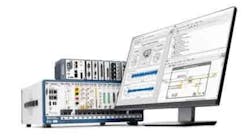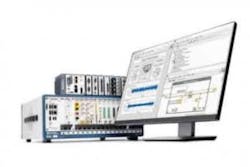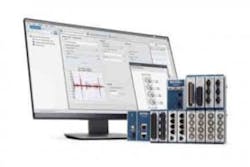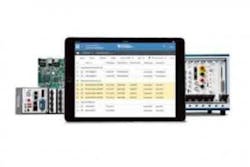Austin, TX. NIWeek took place May 21-24 with the host company unleashing new solutions for addressing the challenges emerging from 5G, IoT, and automotive megatrends. Luke Schreier, vice president of marketing at National Instruments, said at a Monday press conference that every trend these days has megatrend potential, with profound implications for the engineering community. Issues include increasing complexity, compressed test times, and smaller engineering teams.
He cited an example of the downside of complexity. A family member, he said, damaged a taillight on his pickup truck. What once would have cost $60 to replace a light bulb and some plastic ended up costing $500 because of the sensors, cameras, and communications modules in the assembly. That’s just one example of the consumer-facing aspects of complexity, he said. There is today a lot more to test and an increasing demand for test equipment.
Consequently, the requirements for test equipment are changing. In a traditional closed system, Schreier said, the “vendor knows best” and provides what’s needed for a specific measurement. If a customer’s test needs change, that customer must appeal to the vendor, who may or may not provide assistance. NI research, he said, finds that 25% of test-equipment users want an API, and 47% expect their vendor to work with them to meet their custom needs.
Conversely, he said, NI supports a platform-based approach in which “the customer knows best” and can take advantage of an open, vibrant ecosystem to address the fundamentally different test requirements resulting from today’s megatrends. The products to be introduced in the following days will be in support of this open-platform approach, he said.
Simplifying system integration
Throughout the software-centric week, NI highlighted the release of LabVIEW 2018. With the new release, the company said, engineers can increase their speed of innovation by taking advantage of new tools that simplify system integration and grant more control through hardware accessibility. NI also announced the release of InstrumentStudio software for NI PXI modular instruments, SystemLink application software for distributed systems management, and FlexLogger configuration-based data-logging software for validation test.
Engineers can use LabVIEW 2018 to address a multitude of the trends Schreier addressed. They can integrate more third-party IP from tools like Python to make the most of the strengths of each package or existing IP from their stakeholders. Test engineers can use new functionality in LabVIEW 2018 to strengthen code reliability by automating the building and execution of software through integration with open interface tools like Jenkins for continuous delivery. Capabilities like this empower test engineers to focus on system integration and development where they can offer unique differentiation, rather than get bogged down in the semantics of how to use software tools or move IP from one to another. For test engineers using FPGAs for high-performance processing, new deep-learning functions and improved floating-point operations can reduce time to market.
Chris Cilino, LabVIEW framework architect at Cirrus Logic, said at a keynote session that NI’s commitment to its software-centric platform accelerates his productivity so he can focus on the challenges of optimizing yield and obtaining the highest ROIs. “LabVIEW continues to minimize the effort of adding tests and code modifications to our validation framework, delivering a consistent process to maintain our software and incorporate the reuse of valuable IP without rewrites,” he said.
Software for modular instruments
NI said its new InstrumentStudio improves the live, interactive-use model for modular instruments and makes debugging while running tests more intuitive. Engineers in the aerospace, automotive, and semiconductor industries benefit from a more effective workflow for test-system development, the company said.
InstrumentStudio evolves the concept of single-instrument soft front panels into a unified, multi-instrument environment, so engineers can capture screenshots and measurement results in one view from their suite of instruments. InstrumentStudio can also save project-level configurations for specific devices under test that can be repurposed later or shared with colleagues. This efficiency is key for testing high-mix devices and provides test repeatability at a convenience to the engineer or technician.
At different stages in the product design cycle, test engineers often waste time correlating measurements between similar tests that ultimately use different hardware. And in production test, engineers who need to debug on the manufacturing floor may invest in separate hardware, either for monitoring their tests or debugging their automated test equipment.
InstrumentStudio addresses these challenges by exporting configuration files to programming environments that reproduce settings, thereby simplifying measurement correlation. In addition, test engineers can monitor PXI instrument behavior by running InstrumentStudio while test sequences execute in parallel, streamlining the debug process. Through these seamless interactions with programming environments and test sequences, InstrumentStudio becomes part of a comprehensive software workflow and helps engineers maximize their investment in PXI instrumentation.
“For two decades, test and validation engineers have reduced their total cost of test and brought products to market faster using modular instruments on the PXI platform,” said Schreier. “InstrumentStudio makes using NI PXI instruments even easier—from initial product discovery to system debugging—all with intuitive connections to programming environments and test sequencers. It’s a valuable tool in unlocking the full potential and usability of your bench or automated test rack.”
Improving operational efficiency
NI also introduced SystemLink, which the company said helps improve operational efficiency and decrease maintenance costs through a centralized interface for automating tasks such as software deployment, remote device configuration, and system health performance monitoring.
The company reported that the trends Schreier mentioned, coupled with the realities of maintaining distributed legacy systems, are inspiring companies to seek new approaches to systems management. Consequently, companies must balance their adoption of new, connected technologies while preserving support for valuable legacy assets with long life cycles.
Systems that manage, maintain, and extract insight from small-scale pilots or groups of systems are relatively straightforward to implement. However, attention is shifting toward the next challenge, which is scaling and managing large deployments, varying lifecycle stages, and distributed testers and nodes across entire plants, fabs, and factories. This challenge includes tasks like remote software and system configuration as well as data management and performance monitoring, and it applies to industries such as aerospace and defense, transportation, and manufacturing.
SystemLink enables engineers to connect, deploy, and manage distributed systems, both NI and third-party, through a centralized interface accessible from anywhere, making it possible for them to remotely configure and deploy software, monitor the health and performance of their equipment, manage alarms, and visualize application parameters. In addition, engineers can automate the communication of data to customer-defined dashboards and remote operator interfaces.
Configuration-based data-logging
NI also introduced FlexLogger, which the company described as configuration-based data-logging software for validation test that offers intuitive workflows and integrated data management. FlexLogger helps automotive test departments, for example, quickly capture accurate, well-documented data to verify system functionality in real-world conditions and comply with strict government regulations.
NI said technology innovations in areas like active safety, electrification, and vehicle-to-everything (V2X) communication are disrupting how the automotive industry designs, tests, and produces vehicles. Rapidly evolving components and systems including sensor fusion, high-capacity batteries, and deep learning demand a higher volume of testing with accurate, traceable results to exceed safety-critical expectations for quality and reliability. These trends are pulling automotive test departments in different directions, intensifying challenges to build increasingly complex, mixed-measurement test systems under compressed timelines, while managing the explosive growth of collected data.
Engineers can use FlexLogger to help simplify test configurations and extract key insights with sensor-specific workflows to acquire and log synchronized, mixed measurements, NI said. Engineers can integrate analog sensors, digital pulse frequencies, CAN signals, and calculated channels that are all logged to the universal Technical Data Management Streaming (TDMS) file format, so data can be correlated and analyzed to accurately characterize an entire system. These capabilities also address similar challenges faced by test departments in other industries including heavy equipment, aerospace, appliances, and academic research.
Acquisition and signal-conditioning
Also at NIWeek 2018, PVI Systems Inc., a National Instruments Gold Alliance Partner, said it had recently entered into a strategic partnership with Precision Filters Inc., explaining that PVI Systems’ Chameleon will interface with Precision Filters’ 28000 signal-conditioning hardware to facilitate consistent testing and system checkout. The integrated acquisition and signal-conditioning system targets users who need to capture sensor data cleanly and accurately.
Chameleon offers compatibility with a variety of NI CompactDAQ and PXI controllers. Customers include aerospace and defense as well as manufacturing industries. The 28000 systems include signal conditioners suitable for either dynamic or static measurements and accommodate a variety of transducers that measure voltage, charge, and static or dynamic strain (including high-temperature strain). They also support any bridge-type transducers such as pressure sensors, piezoresistive accelerometers, and load cells.
“Since my early days of engineering in the 1980s, Precision Filters has always been the gold standard when it comes to signal conditioning and filtering,” said PVI Systems president Will Schramm, in a press release. “PVI is very excited to have the opportunity to build an integrated system featuring both technologies to the test community.”
Added Precision Filters president and CEO Doug Firth, “Precision Filters is excited to partner with PVI Systems to provide our test-cell customers with a seamless user experience, integrating our signal-conditioning system products with National Instruments’ digitizers.”EE



